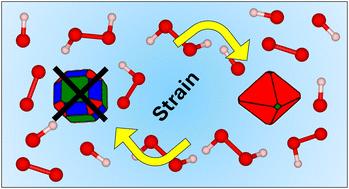Modelling hydrogen peroxide adsorption on cerium dioxide: the effect of surface strain†
IF 4.2
3区 化学
Q2 CHEMISTRY, PHYSICAL
引用次数: 0
Abstract
Ceria nanoparticles are nanozymes that can serve as important biomedical tools mimicking enzymes. The main issue with using metal oxide nanoparticles is the control of their surface speciation, which ultimately affects catalytic activity. Herein, we employ density functional theory calculations to unravel the adsorption of hydrogen peroxide and its dissociation products (hydroxyl, peroxide, superoxide and hydroperoxide) and the effect of strain on the absorption. Indeed, all nanoparticles are affected by intrinsic strain. We found that molecular H2O2 is unstable on the {100} surface at all strains, whereas hydroxyl radicals can be stabilized on reduced surfaces because of the electron transfer from surface Ce3+. Upon dissociation, the peroxide ion is not always the most stable adsorbed species on all surfaces, whether strained, unstrained, stoichiometric or reduced, and superoxide species may also occur under tensile strains. Our thermodynamic methodology connects atomic-level findings to particle morphology in relation to environmental factors such as temperature and vapor pressure. Regardless of the strain applied, the adsorption of hydrogen peroxide and its dissociation products fails to access nanoparticle shapes other than octahedral, which is not ideal for peroxidase activity considering the characteristics of the {111} surface which is less effective in anchoring the adsorbed species.

过氧化氢对二氧化铈吸附的模拟:表面应变†的影响
二氧化铈纳米颗粒是一种纳米酶,可以作为重要的生物医学工具来模拟酶。使用金属氧化物纳米颗粒的主要问题是控制其表面形态,这最终会影响催化活性。本文采用密度泛函理论计算来揭示过氧化氢及其解离产物(羟基、过氧化物、超氧化物和过氧化氢)的吸附以及应变对吸收的影响。事实上,所有的纳米颗粒都受到本征应变的影响。我们发现H2O2分子在所有菌株的{100}表面上都是不稳定的,而羟基自由基可以在还原表面上稳定,因为表面Ce3+的电子转移。在解离时,过氧化物离子并不总是在所有表面上最稳定的吸附物质,无论是应变的、非应变的、化学计量的还是还原的,在拉伸应变下也可能出现超氧化物。我们的热力学方法将原子水平的发现与与环境因素(如温度和蒸气压)相关的粒子形态联系起来。无论施加何种应变,过氧化氢及其解离产物的吸附都不能达到八面体以外的纳米颗粒形状,考虑到{111}表面的特性,这对于过氧化物酶活性来说不是理想的,因为它在锚定吸附物质方面效果较差。
本文章由计算机程序翻译,如有差异,请以英文原文为准。
求助全文
约1分钟内获得全文
求助全文
来源期刊

Catalysis Science & Technology
CHEMISTRY, PHYSICAL-
CiteScore
8.70
自引率
6.00%
发文量
587
审稿时长
1.5 months
期刊介绍:
A multidisciplinary journal focusing on cutting edge research across all fundamental science and technological aspects of catalysis.
Editor-in-chief: Bert Weckhuysen
Impact factor: 5.0
Time to first decision (peer reviewed only): 31 days
 求助内容:
求助内容: 应助结果提醒方式:
应助结果提醒方式:


